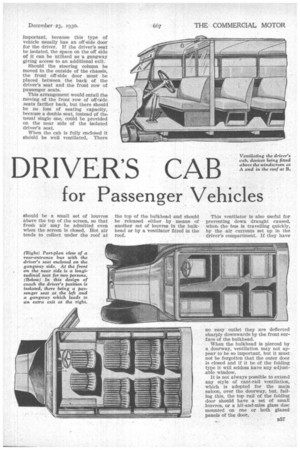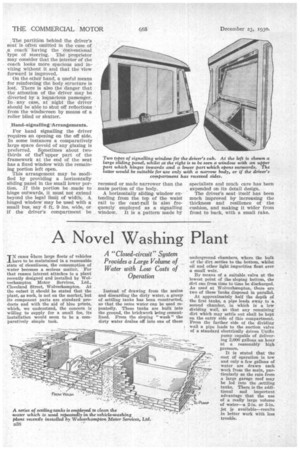DESIGNS OF DRIVER'S CAB
Page 50

Page 51

Page 52

If you've noticed an error in this article please click here to report it so we can fix it.
for Passenger Vehicles
WHEN the chassis has the normal pattern of steeling control, the driver's compartment of the bus or coach occupies from 3 ft. 9 ins. to 4 ft. of the body space. The length depends chiefly on the amount of room taken up by the steering column and wheel. because the allowance for the driver does not vary much. He requires about 1. ft. 3 ins, from the back of the steering wheel to the face of the back-rest or squab, which is usually some 3 ins. thick.
Position of the Steering Column.
An average measurement from the centre line of the chassis to that of the steering column is 10 ins. The latter centre line should also represent the centre line of the driver's seat position. As the driver should be allowed at least 8 ins, each side of this line, it will be seen, therefore, that one end of his seat will be within 2 ins, of the centre line of the n36 chassis, which is also the centre line of the body.
Owing to this position of the steering, the driver's seat, if continued to the off side of the body, is half the width of the vehicle. Consequently, half of the seat is wasted, and if the • bus has a front entrance the bulkhead entrance has to be considerably offset.
It would appear that this position of the steering column is one which was determined in the first instance for a goods-carrying chassis having a driver's cab wide enough to accommodate only one person in addition to the driver.
Although the passenger chassis has in many respects been improved in order .to give scope for better designs of bodywork, this somewhat important item has been ovcrlooked.
If one examines the forwardcontrol passenger chassis it will be found that the steering-column centre is about 1 ft. 8 ins, from the centre of the chassis, or twice the amount as with normal control. Moreover, it is in, such a position that the base of the -steering column may be Mounted outside, instead of
inside, the side-members of the chassis.
With the column so placed for normal steering the general design of the driver's compartment of a front-entrance bus would be much improved, because the bulkhead entrance would then be centrally disposed. The width of this entrance could also be increased and each passenger occupying the front row of seats would enjoy the same amount of comfort. The entrance, as now arranged, favours the offside-seat passengers.
Enclosing the Driver.
When the bus has a rear entrance full use may be made of the space available on the near side of the driver by incorporating it in the main saloon. The driver's seat is enclosed by fixing a partition running lengthwise from the centre of the windscreen to the half-width panel behind the seat. This partition may have a sliding window or be provided with a door. Opposite this partition there is a lengthwise seat for two passengers.
This type of seat is adopted because a sufficient width of gangway remains between the front of the cushion and the end partition of the driver's compartment for a passenger comfortably to reach the seat, whereas if a crosswise seat were used only .a single one would be possible, because a double one would leave no gangway.
But with the steering column moved 10 ins, or so outwards this front seat could be made a double one and face forwards, owing to the fact that the main central gangway could be extended. " With the coach, any alteration of the steering column position is not so . , „ should be a small set of louvres alvve the top of the screen, so that fresh air may be admitted even when the screen is closed. Hot air tends to collect under the roof at the top of the bulkhead and should be released either by means of another set of louvres in the bulkhead or by a ventilator fitted in the roof. This ventilator is also useful for preventing down draught caused, when• the bus -is travelling quickly, by the air currents set up in the driver's compartment. If they have no easy outlet they are deflected sharply downwards by the front surface of the bulkhead.
When the bulkhead is pierced by a doorway, ventilation may not appear to be so important, but it must not be forgotten that the outer door is closed and if it be of the folding type it will seldom have any adjustable window.
It is not always possible to extend any style of cant-rail ventilation, which is adopted for the main saloon, over the doorway, but, failing this, the top rail of the folding door should have a set of small louvres, or a hit-and-miss glass disc mounted on one or both glazed panels of the door,
The partition behind the driver's seat is often omitted in the case of a coach having the conventional -type of steering. The proprietor may consider that the interior of the coach looks more spacious and inviting without it and that the view forward is improved.
On the other hand, a useful means for reinforcing the body structure is lost. There is also the danger that the attention of the driver may be diverted by a loquacious passenger. In any case, at night the driver should be able to shut off reflections from the windscreen by means of a roller blind or shutter.
.1Iand-signalling Arrangements.
For hand signalling the driver requires an opening on the off side. In some instances a comparatively large space devoid of any glazing is preferred. Sometimes about twothirds of thel 'upper part of the framework at the end of the seat has a fixed window with the remaining portion left open.
This arrangement may be modified by providing a horizontally sliding panel in the small lower portion. If this portion be made to hinge outwards, it must not extend beyond the legal limit of width. A hinged window may be used with a small bus, say 6 ft 9 ins, wide, or if the driver's compartment be recessed or made narrower than the main portion of the body.
A horizontally sliding window extending from the top of the waist rail to the cant-rail is also frequently employed as a signalling window. It is a pattern made by
specialists and much care has been expended on its detail design.
The driver's seat itself has been much improved by increasing the thickness and resilience of the cushion, and making it wider from front to back, with a small rake.




























































































